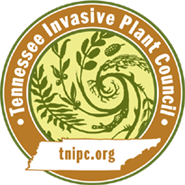Trapa natans L.
Water Caltrop, Water Chestnut
| Threat Level |
Category |
| Emerging |
Aquatic |

Description
Stem
Water Chestnut is a rooted, floating plant that invades shallow to deep, fresh water habitats. It can grow in 12 to 15 ft. (3.6 to 4.6 m) of water and forms dense, floating mats, often three layers deep.
Leaves
The rosette of leaves on the surface of the water are alternate, triangular in shape, strongly dentate (toothed), and connected to the stem by an inflated petiole. Submerged leaves are feathery and either opposite or alternate.
Flowers
T. natans has small, four-petaled flowers that bloom from July to frost.
Fruit
The nut-like fruit of
T. natans has two to four, 0.5 in. (1.3 cm) long, sharp, barbed spines. They ripen in about a month and can remain viable as long as 12 years. Each seed can produce 1 to 15 rosettes and each rosette can produce as many as 20 seeds. The spines can penetrate shoes.
Images
Photo: Leslie J. Mehrhoff, University of Connecticut, Bugwood.org
More images of Trapa natansLife History
Water chestnut was first observed in North America near Concord, Massachusetts in 1859. The exact path for the introduction is unknown. It has been declared a noxious weed in Arizona, Massachusetts, North Carolina and South Carolina and its sale is prohibited in most southern states.
Habitat
Water chestnut can grow in any freshwater setting, from intertidal waters to 12 feet deep, although it prefers nutrient-rich lakes and rivers.
Origin and Distribution
Presently, the plant is found in MD, MA, NY and PA, with most problematic populations occurring in the Connecticut River valley, Lake Champlain region, Hudson River, Potomac River and the upper Delaware River.
Management Recommendations
Specialized methods of control are required to handle water chestnut infestations. Because of the likelihood of unintentional spread offsite and injury to those attempting control, only trained and certified persons should undertake management. Manual, mechanical and chemical techniques are used in its control. Complete removal of plants is imperative, as floating, uplifted plants and plant parts can spread the plant to new locations. It is critical that any removal take place prior to the July seed set. Eradication is difficult because water chestnut seeds may lay dormant for up to 12 years. Biological controls are being investigated, but no species have been approved for release

